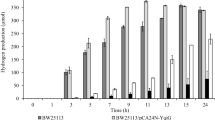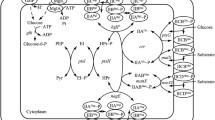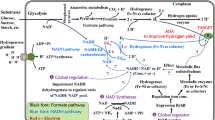Abstract
Although Escherichia coli has four hydrogenases, their definite roles in fermentation are still not clear. In this study, all the operon deletion mutants of E.coli hydrogenases (∆hya, ∆hyb, ∆hyc, or ∆hyf) were constructed to evaluate the hydrogen metabolism in comparison to their respective single-gene deletion mutants of large subunits (∆hyaB, ∆hybC, ∆hycE, and ∆hyfG). Besides the hyc operon mutant that expectedly showed no hydrogen synthesis, the hyb operon mutant showed low hydrogen production and demonstrated significantly reduced growth under anaerobic conditions. The present work also provided first-hand data where deleterious effects of operon deletion were compared with single-gene deletion mutations and the results showed that the former type of deletion was found to cause more prominent phenotypic effects than the latter one. Interestingly, hyb operon mutant was remarkably distinct from other operon mutants, specifically in its inability to utilize glucose under both aerobic and anaerobic conditions. Further studies on this mutant revealed a significant reduction of the total intracellular ATP and NADH concentrations, which could explain its impaired glucose metabolism. In this way, Hyd-2 was verified as crucial not only in glucose metabolism but also in energy balance and redox homeostasis of the cells. Furthermore, a decreased expression of glucose metabolism-associated genes, particularly ppc and pykA, indicated their regulation by hyb operon, and thereby, glucose consumption. Moreover, the transcriptional changes in this mutant indicated the wide genomic connectivity of hyb operon to other metabolisms.






Similar content being viewed by others
Availability of data and materials
Available upon the request.
Code availability
Not applicable.
References
Andrews SC, Berks BC, McClay J, Ambler A, Quail MA, Golby P, Guest JR (1997) A 12-cistron Escherichia coli operon (hyf) encoding a putative proton-translocating formate hydrogenlyase system. Microbiology (reading) 143:3633–3647. https://doi.org/10.1099/00221287-143-11-3633
Andrews S (2010) FastQC a quality control tool for high throughput sequence data. http://www.bioinformatics.babraham.ac.uk/projects/fastqc; https://github.com/s-andrews/FastQC/issues/. Accessed 27 Aug 2020
Baba T, Ara T, Hasegawa M, Takai Y, Okumura Y, Baba M, Datsenko KA, Tomita M, Wanner BL, Mori H (2006) Construction of Escherichia coli K-12 in-frame, single-gene knockout mutants: the Keio collection. Mol Syst Biol 2(2006):0008. https://doi.org/10.1038/msb4100050
Ballantine SP (1986) Boxer DH (1986) Isolation and characterisation of a soluble active fragment of hydrogenase isoenzyme 2 from the membranes of anaerobically grown Escherichia coli. Eur J Biochem 156:277–284. https://doi.org/10.1111/j.1432-1033.1986.tb09578.x
Blokesch M, Böck A (2006) Properties of the [NiFe]-hydrogenase maturation protein HypD. FEBS Lett 580:4065–4068. https://doi.org/10.1016/j.febslet.2006.06.045
Bommer GT, Schaftingen EV, Veiga-da-Cunha M (2019) Metabolite repair enzymes control metabolic damage in glycolysis. Trends Biochem Sci 45:228–243. https://doi.org/10.1016/j.tibs.2019.07.004
Bowles LK, Ellefson WL (1985) Effects of butanol on Clostridium acetobutylicum. Appl Environ Microbiol 50:1165–1170. https://doi.org/10.1128/aem.50.5.1165-1170.1985
Carlson R, Srienc F (2004) Fundamental Escherichia coli biochemical pathways for biomass and energy production: Identification of reactions. Biotechnol Bioeng 85:1–19. https://doi.org/10.1002/bit.10812
Christensen CE, Karlsson M, Winther JR, Jensen PR, Lerche MH (2014) Non-invasive in-cell determination of free cytosolic [NAD+]/[NADH] ratios using hyperpolarized glucose show large variations in metabolic phenotypes. J Biol Chem 289:2344–2352. https://doi.org/10.1074/jbc.M113.498626
Datsenko KA, Wanner BL (2000) One-step inactivation of chromosomal genes in Escherichia coli K-12 using PCR products. Proc Natl Acad Sci USA 97:6640–6645. https://doi.org/10.1073/pnas.120163297
Donner J, Reck M, Bunk B, Jarek M, App CB, Meier-Kolthoff JP, Overmann J, Müller R, Kirschning A, Wagner-Döbler I (2017) The biofilm inhibitor carolacton enters Gram-negative cells: studies using a TolC-deficient strain of Escherichia coli. mSphere 2:e00375-e417. https://doi.org/10.1128/mSphereDirect.00375-17
Goodall ECA, Robinson A, Johnston IG, Jabbari S, Turner KA, Cunningham AF (2018) The essential genome of Escherichia coli K-12. Mbio 9:e02096-e2117. https://doi.org/10.1128/mBio.02096-17
Hallenbeck PC (2014) Microbial paths to renewable hydrogen production. Biofuels 2:285–302. https://doi.org/10.4155/bfs.11.6
Hallenbeck PC, Benemann JR (2002) Biological hydrogen production: fundamentals and limiting processes. Int J Hydrog Energy 27:1185–1193. https://doi.org/10.1016/S0360-3199(02)00131-3
Holm AK, Blank LM, Oldiges M, Schmid A, Solem C, Jensen PR, Vemuri GN (2010) Metabolic and transcriptional response to cofactor perturbations in Escherichia coli. J Biol Chem 285:17498–17506. https://doi.org/10.1074/jbc.M109.095570
Jiang GR, Nikolova S, Clark DP (2001) Regulation of the ldhA gene, encoding the fermentative lactate dehydrogenase of Escherichia coli. Microbiology 147:2437–2446. https://doi.org/10.1099/00221287-147-9-2437
Kargeti M, Venkatesh KV (2017) The effect of global transcriptional regulators on the anaerobic fermentative metabolism of Escherichia coli. Mol BioSyst 13:1388–1398. https://doi.org/10.1039/C6MB00721J
Kim M, Rai N, Zorraquino V, Tagkopoulos I (2016) Multi-omics integration accurately predicts cellular state in unexplored conditions for Escherichia coli. Nat Commun 7:13090. https://doi.org/10.1038/ncomms13090
King PW, Przybyla AE (1999) Response of hya expression to external pH in Escherichia coli. J Bacteriol 181:5250–5256. https://doi.org/10.1128/JB.181.17.5250-5256.1999
Langmead B, Salzberg S (2012) Fast gapped-read alignment with Bowtie 2. Nat Methods 9:357–359. https://doi.org/10.1038/nmeth.1923
Laurinavichene TV, Zorin NA, Tsygankov AA (2002) Effect of redox potential on activity of hydrogenase 1 and hydrogenase 2 in Escherichia coli. Arch Microbiol 178:437–442. https://doi.org/10.1007/s00203-002-0471-x
Leonhartsberger S, Korsa I, Böck A (2002) The molecular biology of formate metabolism in enterobacteria. J Mol Microbiol Biotechnol 4:269–276
Maeda T, Sanchez-Torres V, Wood TK (2007) Enhanced hydrogen production from glucose by metabolically engineered Escherichia coli. Appl Microbiol Biotechnol 77:879–890. https://doi.org/10.1007/s00253-007-1217-0
Maeda T, Sanchez-Torres V, Wood TK (2008a) Metabolic engineering to enhance bacterial hydrogen production. Microb Biotechnol 1:30–39. https://doi.org/10.1111/j.1751-7915.2007.00003.x
Maeda T, Sanchez-Torres V, Wood TK (2008b) Protein engineering of hydrogenase 3 to enhance hydrogen production. Appl Microbiol Biotechnol 79:77–86. https://doi.org/10.1007/s00253-008-1416-3
Maeda T, Tran KT, Yamasaki R, Wood TK (2018) Current state and perspectives in hydrogen production by Escherichia coli: roles of hydrogenases in glucose or glycerol metabolism. Appl Microbiol Biotechnol 102:2041–2050. https://doi.org/10.1007/s00253-018-8752-8
Magoc T, Wood D, Salzberg SL (2013) EDGE-pro: estimated degree of gene expression in prokaryotic genomes. Evol Bioinform 9:127–136. https://doi.org/10.4137/EBO.S11250
Malcovati M, Kornberg HL (1969) Two types of pyruvate kinase in Escherichia coli K12. Biochim Biophys Acta 178:420–423. https://doi.org/10.1016/0005-2744(69)90417-3
Martin M (2011) Cutadapt removes adapter sequences from high-throughput sequencing reads. Embnet J 17:10–12. https://doi.org/10.14806/ej.17.1.200
Menon NK, Robbins J, Wendt JC, Shanmugam KT, Przybyla AE (1991) Mutational analysis and characterization of the Escherichia coli hya operon, which encodes [NiFe] hydrogenase 1. J Bacteriol 173:4851–4861. https://doi.org/10.1128/jb.173.15.4851-4861.1991
Menon NK, Chatelus CY, Dervartanian M, Wendt JC, Shanmugam KT, Peck HD Jr, Przybyla AE (1994) Cloning, sequencing, and mutational analysis of the hyb operon encoding Escherichia coli hydrogenase 2. J Bacteriol 176:4416–4423. https://doi.org/10.1128/jb.176.14.4416-4423.1994
Millard CS, Chao YP, Liao JC, Donnelly MI (1996) Enhanced production of succinic acid by overexpression of phosphoenolpyruvate carboxylase in Escherichia coli. Appl Environ Microbiol 62:1808–1810. https://doi.org/10.1128/aem.62.5.1808-1810.1996
Mirzoyan S, Romero-Pareja PM, Coello MD, Trchounian A, Trchounian K (2017) Evidence for hydrogenase-4 catalyzed biohydrogen production in Escherichia coli. Int J Hydrog Energy 42:21697–21703. https://doi.org/10.1016/j.ijhydene.2017.07.126
Mirzoyan S, Trchounian A, Trchounian K (2018) Role of hydrogenases 3 and 4 in Escherichia coli growth and H2 producing hydrogenase activity during anaerobic utilization of lactose. Int J Hydrog Energy 43:18151–18159. https://doi.org/10.1016/j.ijhydene.2018.08.032
Morita T, El-Kazzaz W, Tanaka Y, Inada T, Aiba H (2003) Accumulation of glucose 6-phosphate or fructose 6-phosphate is responsible for destabilization of glucose transporter mRNA in Escherichia coli. J Biol Chem 278:15608–15614. https://doi.org/10.1074/jbc.M300177200
Nath K, Kumar A, Das D (2006) Effect of some environmental parameters on fermentative hydrogen production by Enterobacter cloacae DM11. Can J Microbiol 52:525–532. https://doi.org/10.1139/w06-005
Pandey A, Chang JS, Hallenbeck P, Larroche C (2013) Biohydrogen. Elsevier, Oxford
Payot S, Guedon E, Cailliez C, Gelhyane E, Petitdemange H (1998) Metabolism of cellobiose by Clostridium cellulolyticum growing in continuous culture: evidence for decreased NADH reoxidation as a factor limiting growth. Microbiology 144:375–384. https://doi.org/10.1099/00221287-144-2-375
Penfold DW, Forster CF, Macaskie LE (2003) Increased hydrogen production by Escherichia coli strain HD701 in comparison with the wild-type parent strain MC4100. Enzyme Microb Technol 33:185–189. https://doi.org/10.1016/S0141-0229(03)00115-7
Pfaffl MW (2001) A new mathematical model for relative quantification in real-time RT–PCR. Nucleic Acids Res 29:e45. https://doi.org/10.1093/nar/29.9.e45
Plumbridge J (2002) Regulation of gene expression in the PTS in Escherichia coli: the role and interactions of Mlc. Curr Opin Microbiol 5:187–193. https://doi.org/10.1016/S1369-5274(02)00296-5
Rasmussen LJ, Møller PL, Atlung T (1991) Carbon metabolism regulates expression of the pfl (pyruvate formate-lyase) gene in Escherichia coli. J Bacteriol 173:6390–6397. https://doi.org/10.1128/jb.173.20.6390-6397.1991
Redwood MD, Mikheenko IP, Sargent F, Macaskie LE (2008) Dissecting the roles of Escherichia coli hydrogenases in biohydrogen production. FEMS Microbiol Lett 278:48–55. https://doi.org/10.1111/j.1574-6968.2007.00966.x
Robinson MD, McCarthy DJ, Smyth GK (2010) edgeR: a Bioconductor package for differential expression analysis of digital gene expression data. Bioinformatics 26:139–140. https://doi.org/10.1093/bioinformatics/btp616
Russell JB, Diez-Gonzalez F (1997) The effects of fermentation acids on bacterial growth. Adv Microb Physiol 39:205–234. https://doi.org/10.1016/S0065-2911(08)60017-X
Sanchez-Torres V, Maeda T, Wood TK (2009) Protein engineering of the transcriptional activator FhlA to enhance hydrogen production in Escherichia coli. Appl Environ Microbiol 75:5639–5646. https://doi.org/10.1128/AEM.00638-09
Sanchez-Torres V, Mohd Yusoff MZ, Nakano C, Maeda T, Ogawa HI, Wood TK (2013) Influence of Escherichia coli hydrogenases on hydrogen fermentation from glycerol. Int J Hydrog Energy 38:3905–3912. https://doi.org/10.1016/j.ijhydene.2013.01.031
Sapra R, Bagramyan K, Adams MW (2003) A simple energy-conserving system: proton reduction coupled to proton translocation. Proc Natl Acad Sci USA 100:7545–7550. https://doi.org/10.1073/pnas.1331436100
Sargent F (2016) The model [NiFe]-hydrogenases of Escherichia coli. Adv Microb Physiol 68:433–507. https://doi.org/10.1016/bs.ampbs.2016.02.008
Sauter M, Böhm R, Böck A (1992) Mutational analysis of the operon (hyc) determining hydrogenase 3 formation in Escherichia coli. Mol Microbiol 6:1523–1532. https://doi.org/10.1111/j.1365-2958.1992.tb00873.x
Sawers RG, Boxer DH (1986) Purification and properties of membrane-bound hydrogenase isoenzyme 1 from anaerobically grown Escherichia coli K12. Eur J Biochem 156:265–275. https://doi.org/10.1111/j.1432-1033.1986.tb09577.x
Sawers RG, Ballantine SP, Boxer DH (1985) Differential expression of hydrogenase isoenzymes in Escherichia coli K-12: evidence for a third isoenzyme. J Bacteriol 164:1324–1331. https://doi.org/10.1128/jb.164.3.1324-1331.1985
Self WT, Hasona A, Shanmugam KT (2004) Expression and regulation of a silent operon, hyf, coding for hydrogenase 4 isoenzyme in Escherichia coli. J Bacteriol 186:580–587. https://doi.org/10.1128/JB.186.2.580-587.2004
Shekhar C, Maeda T (2022) A simple approach for random genomic insertion–deletions using ambiguous sequences in Escherichia coli. J Basic Microbiol. https://doi.org/10.1002/jobm.202100636
Shekhar C, Kai T, Garcia-Contreras R, Sanchez-Torres V, Maeda T (2021) Evaluation of hydrogen metabolism by Escherichia coli strains possessing only the single hydrogenase in the genome. Int J Hydrog Energy 46:1728–1739. https://doi.org/10.1016/j.ijhydene.2020.10.070
Shimada T, Fujita N, Yamamoto K, Ishihama A (2011) Novel roles of cAMP receptor protein (CRP) in regulation of transport and metabolism of carbon sources. PLoS ONE 6:e20081. https://doi.org/10.1371/journal.pone.0020081
Siddiquee KAZ, Arauzo-Bravo MJ, Shimizu K (2004) Effect of a pyruvate kinase (pykF-gene) knockout mutation on the control of gene expression and metabolic fluxes in Escherichia coli. FEMS Microbiol Lett 235:25–33. https://doi.org/10.1111/j.1574-6968.2004.tb09563.x
Singh A, Lynch MD, Gill RT (2009) Genes restoring redox balance in fermentation-deficient E. coli NZN111. Metab Eng 11:347–354. https://doi.org/10.1016/j.ymben.2009.07.002
Skibinski DA, Golby P, Chang YS, Sargent F, Hoffman R, Harper R, Guest JR, Attwood MM, Berks BC, Andrews SC (2002) Regulation of the hydrogenase-4 operon of Escherichia coli by the sigma(54)-dependent transcriptional activators FhlA and HyfR. J Bacteriol 184:6642–6653. https://doi.org/10.1128/JB.184.23.6642-6653.2002
Srikanth S, Venkata Mohan S, Lalit Babu V, Sarma PN (2010) Metabolic shift and electron discharge pattern of anaerobic consortia as a function of pretreatment method applied during fermentative hydrogen Production. Int J Hydrog Energy 35:10693–10700. https://doi.org/10.1016/j.ijhydene.2010.02.055
Szenk M, Dill KA, de Graff AMR (2017) Why do fast-growing bacteria enter overflow metabolism? Testing the membrane real estate hypothesis. Cell Syst 5:95–104. https://doi.org/10.1016/j.cels.2017.06.005
Tran KT, Maeda T, Wood TK (2014) Metabolic engineering of Escherichia coli to enhance hydrogen production from glycerol. Appl Microbiol Biotechnol 98:4757–4770. https://doi.org/10.1007/s00253-014-5600-3
Trchounian K, Trchounian A (2009) Hydrogenase 2 is most and hydrogenase 1 is less responsible for H2 production by Escherichia coli under glycerol fermentation at neutral and slightly alkaline pH. Int J Hydrog Energy 34:8839–8845. https://doi.org/10.1016/j.ijhydene.2009.08.056
Trchounian K, Trchounian A (2014) Hydrogen producing activity by Escherichia coli hydrogenase 4 (hyf) depends on glucose concentration. Int J Hydrog Energy 39:16914–16918. https://doi.org/10.1016/j.ijhydene.2014.08.059
Trchounian K, Pinske C, Sawers RG, Trchounian A (2011) Dependence on the F0F1-ATP synthase for the activities of the hydrogen-oxidizing hydrogenases 1 and 2 during glucose and glycerol fermentation at high and low pH in Escherichia coli. J Bioenerg Biomembr 43:645–650. https://doi.org/10.1007/s10863-011-9397-9
Trchounian K, Poladyan A, Vassilian A, Trchounian A (2012) Multiple and reversible hydrogenases for hydrogen production by Escherichia coli: dependence on fermentation substrate, pH and the F0F1-ATPase. Crit Rev Biochem Mol Biol 47:236–249. https://doi.org/10.3109/10409238.2012.655375
Trchounian K, Blbulyan S, Trchounian A (2013a) Hydrogenase activity and proton-motive force generation by Escherichia coli during glycerol fermentation. J Bioenerg Biomembr 45:253–260. https://doi.org/10.1007/s10863-012-9498-0
Trchounian K, Soboh B, Sawers RG, Trchounian A (2013b) Contribution of hydrogenase 2 to stationary phase H2 production by Escherichia coli during fermentation of glycerol. Cell Biochem Biophys 66:103–108. https://doi.org/10.1007/s12013-012-9458-7
Trchounian K, Sargsyan H, Trchounian A (2014) Hydrogen production by Escherichia coli depends on glucose concentration and its combination with glycerol at different pHs. Int J Hydrog Energy 39:6419–6423. https://doi.org/10.1016/j.ijhydene.2014.02.050
Vanyan L, Trchounian K (2022) HyfF subunit of hydrogenase 4 is crucial for regulating FOF1 dependent proton/potassium fluxes during fermentation of various concentrations of glucose. J Bioenerg Biomembr 54:69–79. https://doi.org/10.1007/s10863-022-09930-x
Vardar-Schara G, Maeda T, Wood TK (2008) Metabolically engineered bacteria for producing hydrogen via fermentation. Microb Biotechnol 1:107–125. https://doi.org/10.1111/j.1751-7915.2007.00009.x
Yoshida A, Nishimura T, Kawaguchi H, Inui M, Yukawa H (2006) Enhanced hydrogen production from glucose using ldh- and frd-inactivated Escherichia coli strains. Appl Microbiol Biotechnol 73:67–72. https://doi.org/10.1007/s00253-006-0456-9
Yusoff MZ, Maeda T, Sanchez-Torres V, Ogawa HI, Shirai Y, Hassan MA, Wood TK (2012) Uncharacterized Escherichia coli proteins YdjA and YhjY are related to biohydrogen production. Int J Hydrog Energy 37:17778–17787. https://doi.org/10.1016/j.ijhydene.2012.08.115
Zhang X, Jantama K, Shanmugam KT, Ingram LO (2009) Reengineering Escherichia coli for Succinate Production in Mineral Salts Medium. Appl Environ Microbiol 75:7807–7813. https://doi.org/10.1128/AEM.01758-09
Acknowledgements
The authors thank the Inamori Foundation for supporting this study. The authors also thank Dr. Nurul Asyifah Mustapha and Ayaka Imabayashi for their skilled technical assistance and glucose work in the study, respectively.
Funding
This research received no specific grant from any funding agency, therefore, funding was not disclosed in the manuscript by the authors.
Author information
Authors and Affiliations
Contributions
TM designed the study. Experiments and transcriptomic data analysis were done by CS. The manuscript was written by CS. Both the authors read and approved the manuscript.
Corresponding author
Ethics declarations
Conflict of interest
The authors declare that they have no conflict of interest.
Ethics approval
This article does not contain any studies with human participants or animals performed by any of the authors.
Consent to participate
Not applicable.
Consent for publication
Not applicable.
Additional information
Communicated by Erko Stackebrandt.
Publisher's Note
Springer Nature remains neutral with regard to jurisdictional claims in published maps and institutional affiliations.
Supplementary Information
Below is the link to the electronic supplementary material.
Rights and permissions
Springer Nature or its licensor holds exclusive rights to this article under a publishing agreement with the author(s) or other rightsholder(s); author self-archiving of the accepted manuscript version of this article is solely governed by the terms of such publishing agreement and applicable law.
About this article
Cite this article
Shekhar, C., Maeda, T. Impaired glucose metabolism by deleting the operon of hydrogenase 2 in Escherichia coli. Arch Microbiol 204, 627 (2022). https://doi.org/10.1007/s00203-022-03245-6
Received:
Revised:
Accepted:
Published:
DOI: https://doi.org/10.1007/s00203-022-03245-6




